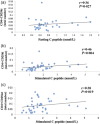Altered regulatory T cell phenotype in latent autoimmune diabetes of the adults (LADA)
- PMID: 27357431
- PMCID: PMC5011368
- DOI: 10.1111/cei.12834
Altered regulatory T cell phenotype in latent autoimmune diabetes of the adults (LADA)
Abstract
Latent autoimmune diabetes of the adults (LADA) accounts for up to 12% of all patients with diabetes. Initially the disease resembles type 2 diabetes (T2D); however, the typical presence of β cell autoantibodies indicates an autoimmune basis of LADA. While dysfunctional regulatory T cells (Tregs ) have been implicated in autoimmune diabetes, these cells have been scarcely studied in LADA. The aim of this study was to investigate the frequency and phenotype of circulating Tregs in LADA patients early during disease progression. Flow cytometric analysis was performed on whole blood and peripheral mononuclear cells (PBMC) from patients diagnosed with LADA prior to insulin deficiency (n = 39) and from healthy volunteers (n = 20). Overall, we found the frequency and activation status of peripheral putative Tregs to be altered in LADA patients compared to healthy controls. While total T cells and CD4(+) T cells expressing high levels of CD25 (CD4(+) CD25(hi) ) were unchanged, the frequency and total numbers of CD4(+) T cells expressing an intermediate level of CD25 (CD4(+) CD25(int) ) were decreased in LADA patients. Interestingly, the expression of the Treg -specific marker forkhead box protein 3 (FoxP3), as well as the activation and memory makers CD69, cytotoxic T lymphocyte associated antigen 4 (CTLA-4), CCR4 and CD45RO were increased in CD4(+) CD25(+) T cells of the patients. Our data depict phenotypical changes in T cells of LADA patients that may reflect a derangement in peripheral immune regulation contributing to the slow process leading to insulin-dependent diabetes in these patients.
Keywords: autoimmunity; diabetes; regulatory T cells.
© 2016 British Society for Immunology.
Figures







References
-
- Tuomi T, Groop LC, Zimmet PZ, Rowley MJ, Knowles W, Mackay IR. Antibodies to glutamic acid decarboxylase reveal latent autoimmune diabetes mellitus in adults with a non‐insulin‐dependent onset of disease. Diabetes 1993; 42:359–62. - PubMed
-
- Tuomi T, Carlsson A, Li H et al Clinical and genetic characteristics of type 2 diabetes with and without GAD antibodies. Diabetes 1999; 48:150–7. - PubMed
-
- Zhang Y, Zhou ZG, Yang L, Lin J, Li X, He WM. [Abnormal T cell autoimmunity against GAD65 in LADA patients]. Zhonghua Yi Xue Za Zhi 2010; 90:1963–5. - PubMed
Publication types
MeSH terms
Substances
LinkOut - more resources
Full Text Sources
Other Literature Sources
Medical
Research Materials

